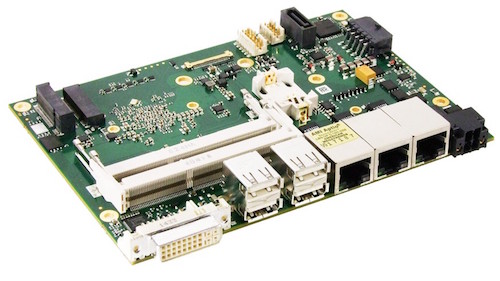Blog
Recent Posts
Industrial-IoT-Ready Board With Intel System-On-Chip (SoC) E3800 Atom Processor
Posted by on
ADL Embedded Solutions Inc., a provider of high-performance embedded solutions, has announced its ADLE3800HDC 3.5” SBC. The ADLE3800HDC is based on Intel’s first System-on-Chip (SoC) E3800-series Atom processors which use Intel’s 22nm 3D Tri-gate process. It offers vastly superior compute performance and energy efficiency and Intel’s 7th generation graphics engine for stunning graphics performance. Improved power management capabilities result in standby power measured in milliwatts with days of standby time.
The ADLE3800HDC is a lower I/O, lower cost version of the ADLE3800HD offering M.2 (Type B) 2242 SATA storage and M.2 (Type B) 2280 PCIex1 expansion. Its high-performance graphics engine is capable of decoding 10 or more streams of 1080p video, has integrated hardware acceleration for video decode of H.264, MVC, VPG8, VC1/WMV9 and others standards.
The ADLE3800HDC is ideal for rugged, extended temperature embedded systems with a thermal junction temperature (Tj) ranging from –40C to +85C. It’s well suited for extreme environments such as industrial control and automation and in-vehicle communication and infotainment systems for commercial transportation systems. Its superior graphics also make it ideal for rugged mobile computing in a variety floor and rugged industrial environments in transportation, energy, oil and gas and similar industries.
=> Download the ADLE3800HDC – Intel E3800-Series (Industrial IoT-Ready) 3.5” SBC data sheet (PDF)...
 Interested in developing embedded systems? Since they don't tolerate inefficiency, these systems require a disciplined approach to programming. This easy-to-read guide helps you cultivate a host of good development practices, based on classic software design patterns and new patterns unique to embedded programming. Learn how to build system architecture for processors, not operating systems, and discover specific techniques for dealing with hardware difficulties and manufacturing requirements.
Interested in developing embedded systems? Since they don't tolerate inefficiency, these systems require a disciplined approach to programming. This easy-to-read guide helps you cultivate a host of good development practices, based on classic software design patterns and new patterns unique to embedded programming. Learn how to build system architecture for processors, not operating systems, and discover specific techniques for dealing with hardware difficulties and manufacturing requirements.
Written by an expert who's created embedded systems ranging from urban surveillance and DNA scanners to children's toys, this book is ideal for intermediate and experienced programmers, no matter what platform you use.
- Optimize your system to reduce cost and increase performance
- Develop an architecture that makes your software robust in resource-constrained environments
- Explore sensors, motors, and other I/O devices
- Do more with less: reduce RAM consumption, code space, processor cycles, and power consumption
- Learn how to update embedded code directly in the processor
- Discover how to implement complex mathematics on small processors
- Understand what interviewers look for when you apply for an embedded systems job
 Loading... Please wait...
Loading... Please wait...

